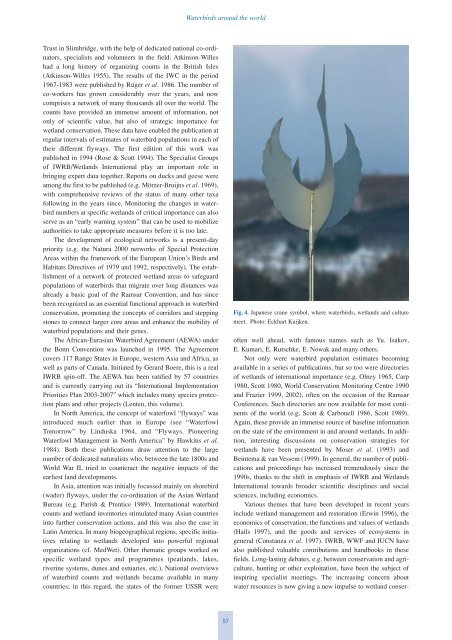A short history of waterbird conservation - Ramsar Convention on ...
A short history of waterbird conservation - Ramsar Convention on ...
A short history of waterbird conservation - Ramsar Convention on ...
Create successful ePaper yourself
Turn your PDF publications into a flip-book with our unique Google optimized e-Paper software.
Waterbirds around the world<br />
Trust in Slimbridge, with the help <str<strong>on</strong>g>of</str<strong>on</strong>g> dedicated nati<strong>on</strong>al co-ordinators,<br />
specialists and volunteers in the field. Atkins<strong>on</strong>-Willes<br />
had a l<strong>on</strong>g <str<strong>on</strong>g>history</str<strong>on</strong>g> <str<strong>on</strong>g>of</str<strong>on</strong>g> organizing counts in the British Isles<br />
(Atkins<strong>on</strong>-Willes 1955). The results <str<strong>on</strong>g>of</str<strong>on</strong>g> the IWC in the period<br />
1967-1983 were published by Rüger et al. 1986. The number <str<strong>on</strong>g>of</str<strong>on</strong>g><br />
co-workers has grown c<strong>on</strong>siderably over the years, and now<br />
comprises a network <str<strong>on</strong>g>of</str<strong>on</strong>g> many thousands all over the world. The<br />
counts have provided an immense amount <str<strong>on</strong>g>of</str<strong>on</strong>g> informati<strong>on</strong>, not<br />
<strong>on</strong>ly <str<strong>on</strong>g>of</str<strong>on</strong>g> scientific value, but also <str<strong>on</strong>g>of</str<strong>on</strong>g> strategic importance for<br />
wetland <str<strong>on</strong>g>c<strong>on</strong>servati<strong>on</strong></str<strong>on</strong>g>. These data have enabled the publicati<strong>on</strong> at<br />
regular intervals <str<strong>on</strong>g>of</str<strong>on</strong>g> estimates <str<strong>on</strong>g>of</str<strong>on</strong>g> <str<strong>on</strong>g>waterbird</str<strong>on</strong>g> populati<strong>on</strong>s in each <str<strong>on</strong>g>of</str<strong>on</strong>g><br />
their different flyways. The first editi<strong>on</strong> <str<strong>on</strong>g>of</str<strong>on</strong>g> this work was<br />
published in 1994 (Rose & Scott 1994). The Specialist Groups<br />
<str<strong>on</strong>g>of</str<strong>on</strong>g> IWRB/Wetlands Internati<strong>on</strong>al play an important role in<br />
bringing expert data together. Reports <strong>on</strong> ducks and geese were<br />
am<strong>on</strong>g the first to be published (e.g. Mörzer-Bruijns et al. 1969),<br />
with comprehensive reviews <str<strong>on</strong>g>of</str<strong>on</strong>g> the status <str<strong>on</strong>g>of</str<strong>on</strong>g> many other taxa<br />
following in the years since. M<strong>on</strong>itoring the changes in <str<strong>on</strong>g>waterbird</str<strong>on</strong>g><br />
numbers at specific wetlands <str<strong>on</strong>g>of</str<strong>on</strong>g> critical importance can also<br />
serve as an “early warning system” that can be used to mobilize<br />
authorities to take appropriate measures before it is too late.<br />
The development <str<strong>on</strong>g>of</str<strong>on</strong>g> ecological networks is a present-day<br />
priority (e.g. the Natura 2000 networks <str<strong>on</strong>g>of</str<strong>on</strong>g> Special Protecti<strong>on</strong><br />
Areas within the framework <str<strong>on</strong>g>of</str<strong>on</strong>g> the European Uni<strong>on</strong>’s Birds and<br />
Habitats Directives <str<strong>on</strong>g>of</str<strong>on</strong>g> 1979 and 1992, respectively). The establishment<br />
<str<strong>on</strong>g>of</str<strong>on</strong>g> a network <str<strong>on</strong>g>of</str<strong>on</strong>g> protected wetland areas to safeguard<br />
populati<strong>on</strong>s <str<strong>on</strong>g>of</str<strong>on</strong>g> <str<strong>on</strong>g>waterbird</str<strong>on</strong>g>s that migrate over l<strong>on</strong>g distances was<br />
already a basic goal <str<strong>on</strong>g>of</str<strong>on</strong>g> the <str<strong>on</strong>g>Ramsar</str<strong>on</strong>g> <str<strong>on</strong>g>C<strong>on</strong>venti<strong>on</strong></str<strong>on</strong>g>, and has since<br />
been recognized as an essential functi<strong>on</strong>al approach in <str<strong>on</strong>g>waterbird</str<strong>on</strong>g><br />
<str<strong>on</strong>g>c<strong>on</strong>servati<strong>on</strong></str<strong>on</strong>g>, promoting the c<strong>on</strong>cepts <str<strong>on</strong>g>of</str<strong>on</strong>g> corridors and stepping<br />
st<strong>on</strong>es to c<strong>on</strong>nect larger core areas and enhance the mobility <str<strong>on</strong>g>of</str<strong>on</strong>g><br />
<str<strong>on</strong>g>waterbird</str<strong>on</strong>g> populati<strong>on</strong>s and their genes.<br />
The African-Eurasian Waterbird Agreement (AEWA) under<br />
the B<strong>on</strong>n <str<strong>on</strong>g>C<strong>on</strong>venti<strong>on</strong></str<strong>on</strong>g> was launched in 1995. The Agreement<br />
covers 117 Range States in Europe, western Asia and Africa, as<br />
well as parts <str<strong>on</strong>g>of</str<strong>on</strong>g> Canada. Initiated by Gerard Boere, this is a real<br />
IWRB spin-<str<strong>on</strong>g>of</str<strong>on</strong>g>f. The AEWA has been ratified by 57 countries<br />
and is currently carrying out its “Internati<strong>on</strong>al Implementati<strong>on</strong><br />
Priorities Plan 2003-2007” which includes many species protecti<strong>on</strong><br />
plans and other projects (Lenten, this volume).<br />
In North America, the c<strong>on</strong>cept <str<strong>on</strong>g>of</str<strong>on</strong>g> waterfowl “flyways” was<br />
introduced much earlier than in Europe (see “Waterfowl<br />
Tomorrow” by Linduska 1964, and “Flyways. Pi<strong>on</strong>eering<br />
Waterfowl Management in North America” by Hawkins et al.<br />
1984). Both these publicati<strong>on</strong>s draw attenti<strong>on</strong> to the large<br />
number <str<strong>on</strong>g>of</str<strong>on</strong>g> dedicated naturalists who, between the late 1800s and<br />
World War II, tried to counteract the negative impacts <str<strong>on</strong>g>of</str<strong>on</strong>g> the<br />
earliest land developments.<br />
In Asia, attenti<strong>on</strong> was initially focussed mainly <strong>on</strong> shorebird<br />
(wader) flyways, under the co-ordinati<strong>on</strong> <str<strong>on</strong>g>of</str<strong>on</strong>g> the Asian Wetland<br />
Bureau (e.g. Parish & Prentice 1989). Internati<strong>on</strong>al <str<strong>on</strong>g>waterbird</str<strong>on</strong>g><br />
counts and wetland inventories stimulated many Asian countries<br />
into further <str<strong>on</strong>g>c<strong>on</strong>servati<strong>on</strong></str<strong>on</strong>g> acti<strong>on</strong>s, and this was also the case in<br />
Latin America. In many biogeographical regi<strong>on</strong>s, specific initiatives<br />
relating to wetlands developed into powerful regi<strong>on</strong>al<br />
organizati<strong>on</strong>s (cf. MedWet). Other thematic groups worked <strong>on</strong><br />
specific wetland types and programmes (peatlands, lakes,<br />
riverine systems, dunes and estuaries, etc.). Nati<strong>on</strong>al overviews<br />
<str<strong>on</strong>g>of</str<strong>on</strong>g> <str<strong>on</strong>g>waterbird</str<strong>on</strong>g> counts and wetlands became available in many<br />
countries; in this regard, the states <str<strong>on</strong>g>of</str<strong>on</strong>g> the former USSR were<br />
Fig. 4. Japanese crane symbol, where <str<strong>on</strong>g>waterbird</str<strong>on</strong>g>s, wetlands and culture<br />
meet. Photo: Eckhart Kuijken.<br />
<str<strong>on</strong>g>of</str<strong>on</strong>g>ten well ahead, with famous names such as Yu. Isakov,<br />
E. Kumari, E. Rutschke, E. Nowak and many others.<br />
Not <strong>on</strong>ly were <str<strong>on</strong>g>waterbird</str<strong>on</strong>g> populati<strong>on</strong> estimates becoming<br />
available in a series <str<strong>on</strong>g>of</str<strong>on</strong>g> publicati<strong>on</strong>s, but so too were directories<br />
<str<strong>on</strong>g>of</str<strong>on</strong>g> wetlands <str<strong>on</strong>g>of</str<strong>on</strong>g> internati<strong>on</strong>al importance (e.g. Olney 1965, Carp<br />
1980, Scott 1980, World C<strong>on</strong>servati<strong>on</strong> M<strong>on</strong>itoring Centre 1990<br />
and Frazier 1999, 2002), <str<strong>on</strong>g>of</str<strong>on</strong>g>ten <strong>on</strong> the occasi<strong>on</strong> <str<strong>on</strong>g>of</str<strong>on</strong>g> the <str<strong>on</strong>g>Ramsar</str<strong>on</strong>g><br />
C<strong>on</strong>ferences. Such directories are now available for most c<strong>on</strong>tinents<br />
<str<strong>on</strong>g>of</str<strong>on</strong>g> the world (e.g. Scott & Carb<strong>on</strong>ell 1986, Scott 1989).<br />
Again, these provide an immense source <str<strong>on</strong>g>of</str<strong>on</strong>g> baseline informati<strong>on</strong><br />
<strong>on</strong> the state <str<strong>on</strong>g>of</str<strong>on</strong>g> the envir<strong>on</strong>ment in and around wetlands. In additi<strong>on</strong>,<br />
interesting discussi<strong>on</strong>s <strong>on</strong> <str<strong>on</strong>g>c<strong>on</strong>servati<strong>on</strong></str<strong>on</strong>g> strategies for<br />
wetlands have been presented by Moser et al. (1993) and<br />
Beintema & van Vessem (1999). In general, the number <str<strong>on</strong>g>of</str<strong>on</strong>g> publicati<strong>on</strong>s<br />
and proceedings has increased tremendously since the<br />
1990s, thanks to the shift in emphasis <str<strong>on</strong>g>of</str<strong>on</strong>g> IWRB and Wetlands<br />
Internati<strong>on</strong>al towards broader scientific disciplines and social<br />
sciences, including ec<strong>on</strong>omics.<br />
Various themes that have been developed in recent years<br />
include wetland management and restorati<strong>on</strong> (Erwin 1996), the<br />
ec<strong>on</strong>omics <str<strong>on</strong>g>of</str<strong>on</strong>g> <str<strong>on</strong>g>c<strong>on</strong>servati<strong>on</strong></str<strong>on</strong>g>, the functi<strong>on</strong>s and values <str<strong>on</strong>g>of</str<strong>on</strong>g> wetlands<br />
(Hails 1997), and the goods and services <str<strong>on</strong>g>of</str<strong>on</strong>g> ecosystems in<br />
general (C<strong>on</strong>stanza et al. 1997). IWRB, WWF and IUCN have<br />
also published valuable c<strong>on</strong>tributi<strong>on</strong>s and handbooks in these<br />
fields. L<strong>on</strong>g-lasting debates, e.g. between <str<strong>on</strong>g>c<strong>on</strong>servati<strong>on</strong></str<strong>on</strong>g> and agriculture,<br />
hunting or other exploitati<strong>on</strong>, have been the subject <str<strong>on</strong>g>of</str<strong>on</strong>g><br />
inspiring specialist meetings. The increasing c<strong>on</strong>cern about<br />
water resources is now giving a new impulse to wetland c<strong>on</strong>ser-<br />
57

















